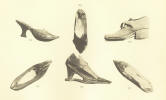
PLATE no. VI
The Greig Collection.
No. 29. Russet leather lady’s walking shoe, period Charles I., with square toes and buckle flaps, in all probability worn with silver buckles. Found at Harley House, Worcestershire. Soles standing out from sides of shoe like the present broad welt.
No. 26. Shoe supposed to have belonged to the beautiful and unfortunate Mary Queen of Scots. Though remarkable for the smallness of its size, it is by no means a specimen of the elaborate workmanship of former days, being made of plain black satin; the simplicity of which, however, would in all probability be relieved by a diamond buckle to fasten, as was the fashion in olden times, with straps which were made to overlap each other across the instep. It is interesting and valuable to the antiquarian on account of its antiquity and of the rank and historical celebrity of its quondam wearer.
No. 23. This mule shoe belonged to Mary of Lorraine; its probable use was that of a bedroom slipper as now worn. It is made of natural- coloured leather, embroidered with narrow braid, the original colour of which was red. The toe is extremely pointed; the heel is very high and peculiarly shaped. Date of shoe sixteenth century.
No. 31. This sew-round shoe is made of brown kid, without stiffening, with a wool rosette. Worn in early part of present century. From the Gibson-Craig Collection.
Shoe-roses, or rosettes, which consisted of bunches of ribbons formed like a rose, and worn upon the shoe, were very fashionable at the Court of Queen Elizabeth, where they were worn as large as saucers, and were constantly alluded to by dramatic writers of that period:
“With two Provençal roses on my razed shoes.”
SHAKESPEARE, Hamlet, act v., scene 2.
“With overblown roses to hide your gouty
ankles.”
The Devil’s Law Case, 1623.
Shoe-roses, more or less full-blown, were worn during the reign of Charles I., and the shoes worn by William IV. at his coronation were decorated with them. They were often laced and jewelled, and are to be seen in several portraits of the period. They again came into fashion amongst ladies about 1850.
No. 30. Red morocco slipper with very pointed toe, flaps fastened with black ribbon tie. It belonged to Rosa Anderson, wife of one of the Provosts of Perth. She eloped with a Scottish earl of the period, and, being deserted, died afterwards in great poverty in Paris.
No. 27. Mary of Lorraine’s shoe. Sixteenth century.
This shoe, of which the workmanship is somewhat rough, is made of brown natural-coloured leather, with two perforated side-flaps and centre thong, which overlapped when worn, and were connected by a lace. The toe is long and square, resembling a duck’s bill in form, and is slightly polished. The soles are two in number, the second and lower one beneath the instep and heel, forming a kind of patten. This shape of shoe was peculiar to the sixteenth century.
Marie, owner of the one above described, was daughter of Claude Lorraine, Duke of Guise. She was born November, 1515; married James V., May, 1538 (being then widow of the Duke of Longueville); she was mother of Mary Queen of Scots, who was born December, 1542; and died 1560.
The shoe was purchased at the Gibson-Craig sale in Edinburgh, March, 1887, and was exhibited in Glasgow, 1888.
Slippers, it may be mentioned, were first worn in the reign of Queen Elizabeth. Startups, which were high shoes opening at the side, were also worn at this period.